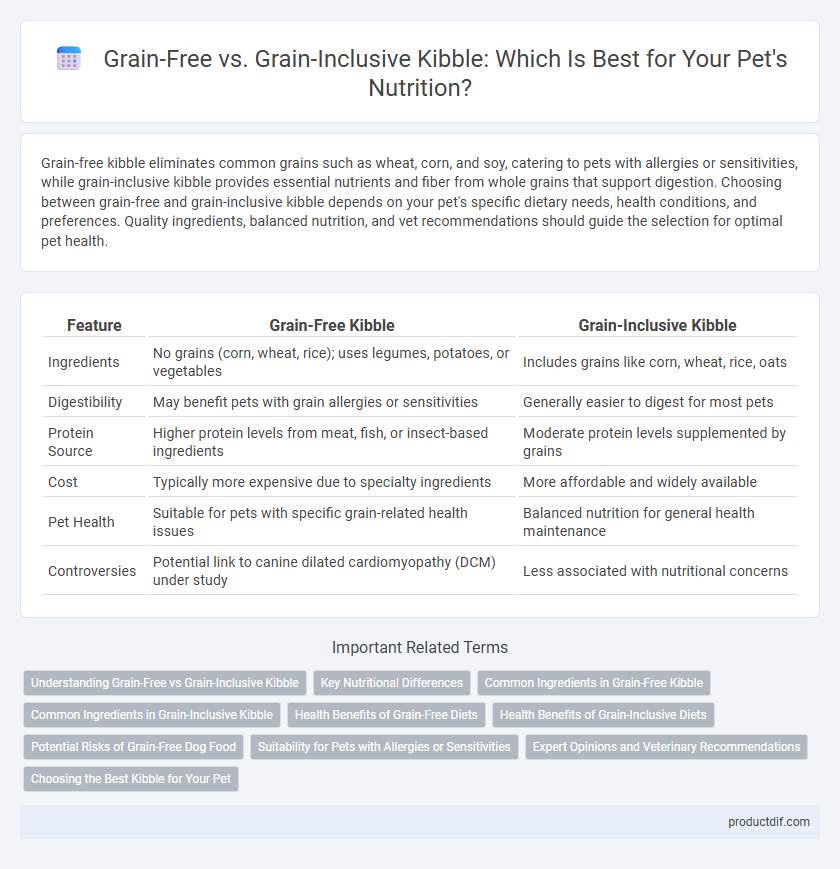Grain-free kibble eliminates common grains such as wheat, corn, and soy, catering to pets with allergies or sensitivities, while grain-inclusive kibble provides essential nutrients and fiber from whole grains that support digestion. Choosing between grain-free and grain-inclusive kibble depends on your pet's specific dietary needs, health conditions, and preferences. Quality ingredients, balanced nutrition, and vet recommendations should guide the selection for optimal pet health.
Table of Comparison
| Feature | Grain-Free Kibble | Grain-Inclusive Kibble |
|---|---|---|
| Ingredients | No grains (corn, wheat, rice); uses legumes, potatoes, or vegetables | Includes grains like corn, wheat, rice, oats |
| Digestibility | May benefit pets with grain allergies or sensitivities | Generally easier to digest for most pets |
| Protein Source | Higher protein levels from meat, fish, or insect-based ingredients | Moderate protein levels supplemented by grains |
| Cost | Typically more expensive due to specialty ingredients | More affordable and widely available |
| Pet Health | Suitable for pets with specific grain-related health issues | Balanced nutrition for general health maintenance |
| Controversies | Potential link to canine dilated cardiomyopathy (DCM) under study | Less associated with nutritional concerns |
Understanding Grain-Free vs Grain-Inclusive Kibble
Grain-free kibble eliminates grains like wheat, corn, and soy to reduce allergens and improve digestion, making it suitable for pets with sensitivities or food allergies. Grain-inclusive kibble contains grains that provide essential nutrients such as fiber, vitamins, and carbohydrates, supporting energy levels and digestive health. Choosing between grain-free and grain-inclusive kibble depends on a pet's specific dietary needs, allergies, and veterinarian recommendations.
Key Nutritional Differences
Grain-free kibble typically contains higher protein levels and fewer carbohydrates due to the absence of grains like corn, wheat, or soy, making it suitable for pets with grain sensitivities or allergies. Grain-inclusive kibble provides essential fiber, vitamins, and minerals from ingredients like rice and barley, which support digestive health and sustained energy release. Nutritional differences impact pet metabolism, allergen exposure, and overall diet balance, influencing choices based on specific pet health needs and lifestyle.
Common Ingredients in Grain-Free Kibble
Grain-free kibble commonly features ingredients such as peas, lentils, chickpeas, and potatoes, which replace traditional grains like corn, wheat, and rice to provide carbohydrates and fiber. Protein sources often include chicken, lamb, or fish to support muscle health, while added supplements like flaxseed and chia seeds contribute omega-3 fatty acids for skin and coat health. The formulation emphasizes allergen-free options and digestibility, appealing to pets with grain sensitivities or food allergies.
Common Ingredients in Grain-Inclusive Kibble
Common ingredients in grain-inclusive kibble typically include corn, wheat, rice, and barley, which serve as primary carbohydrate sources. These grains provide essential nutrients like fiber, vitamins (such as B-complex), and minerals that support digestive health and energy levels in pets. Manufacturers often blend grains with protein sources like chicken meal or beef to create balanced formulas targeting optimal pet nutrition.
Health Benefits of Grain-Free Diets
Grain-free kibble often reduces the risk of allergies and digestive issues in pets sensitive to grains, promoting better nutrient absorption and overall gut health. It typically contains alternative carbohydrate sources like sweet potatoes or peas, which can enhance energy levels without causing inflammation. Veterinarians frequently recommend grain-free diets for pets with specific food intolerances or chronic skin conditions to improve their quality of life.
Health Benefits of Grain-Inclusive Diets
Grain-inclusive kibble provides essential nutrients such as fiber, vitamins, and minerals that support healthy digestion and promote a balanced gut microbiome in pets. The inclusion of whole grains like brown rice and oats contributes to steady energy release and improved cardiovascular health through complex carbohydrates and antioxidants. Scientific studies have shown that grain-inclusive diets may reduce the risk of nutrient deficiencies and support long-term wellness compared to grain-free alternatives.
Potential Risks of Grain-Free Dog Food
Grain-free dog food may pose potential risks such as nutrient deficiencies and an increased likelihood of dilated cardiomyopathy (DCM), a serious heart condition linked to certain grain-free diets. These diets often rely heavily on legumes and potatoes, which can disrupt nutrient balance and affect taurine levels critical for heart health. Consulting a veterinarian before switching to grain-free kibble ensures pets receive balanced nutrition tailored to their specific health needs.
Suitability for Pets with Allergies or Sensitivities
Grain-free kibble is often recommended for pets with allergies or sensitivities as it eliminates common allergens such as wheat, corn, and soy, reducing the risk of adverse reactions. Grain-inclusive kibble can still be suitable for sensitive pets if it contains high-quality, easily digestible grains like brown rice or oats and avoids artificial additives. Consulting a veterinarian to identify specific allergens and choosing a formula tailored to the pet's individual needs ensures optimal nutrition and comfort.
Expert Opinions and Veterinary Recommendations
Veterinary experts emphasize the importance of tailoring pet diets to individual health needs rather than strictly choosing grain-free or grain-inclusive kibble, noting that grain-inclusive diets often provide essential nutrients like fiber and vitamins. Many veterinarians warn that grain-free diets, while beneficial for pets with specific allergies or sensitivities, may increase the risk of heart conditions such as dilated cardiomyopathy in some dogs. Expert opinion generally supports consulting with a veterinarian to determine the most appropriate kibble, balancing grain content with overall nutritional adequacy for optimal pet health.
Choosing the Best Kibble for Your Pet
Grain-free kibble eliminates grains such as corn, wheat, and soy, catering to pets with allergies or sensitivities while often incorporating alternative carbohydrate sources like sweet potatoes or peas. Grain-inclusive kibble provides essential nutrients and fiber from grains that support digestion and overall health in most pets. Selecting the best kibble depends on your pet's specific dietary needs, medical conditions, and preference for natural ingredients, so consult your veterinarian for a tailored nutritional plan.
Grain-Free vs Grain-Inclusive Kibble Infographic

 productdif.com
productdif.com